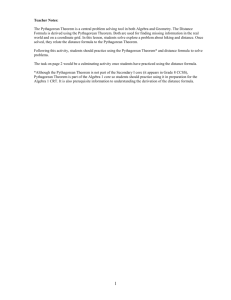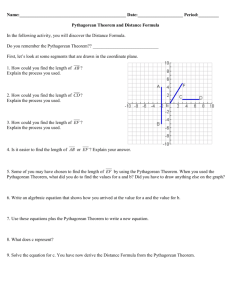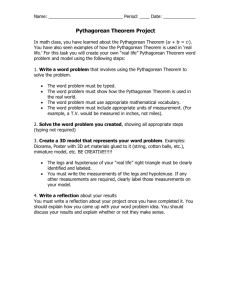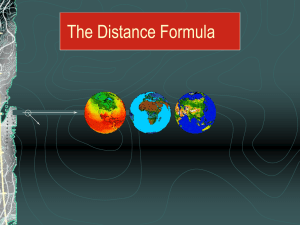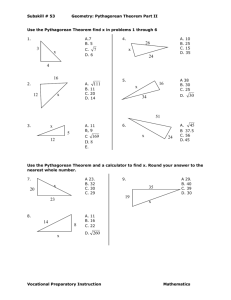TheDistanceFormula(Alg8.3).
advertisement
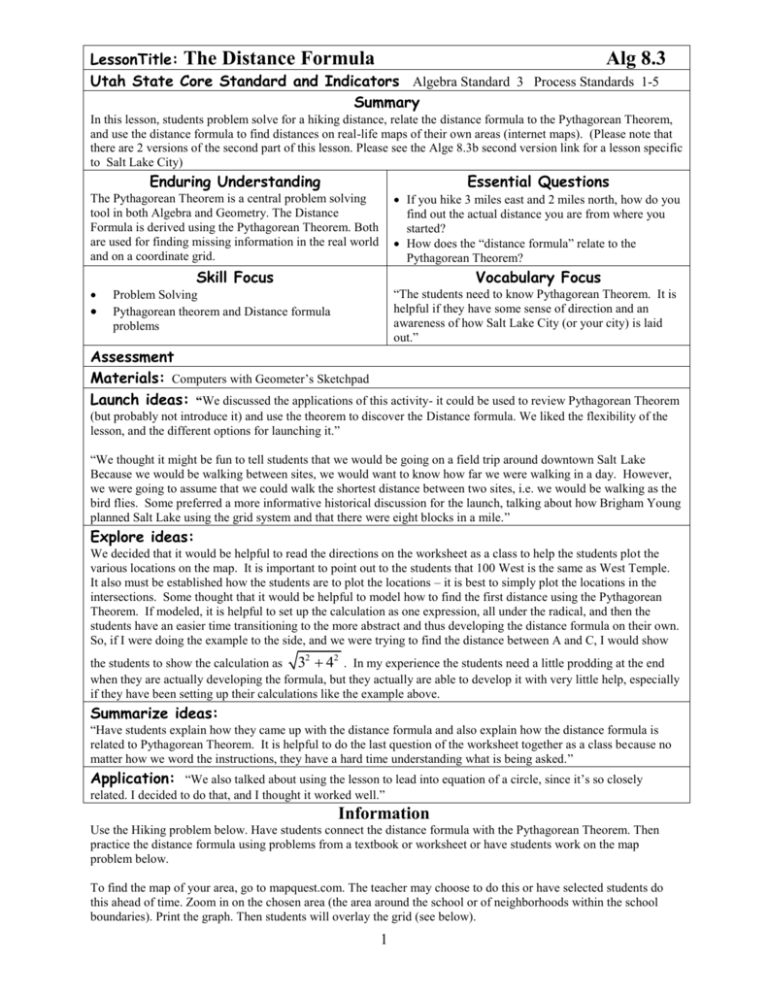
LessonTitle: The Distance Formula Alg 8.3 Utah State Core Standard and Indicators Algebra Standard 3 Process Standards 1-5 Summary In this lesson, students problem solve for a hiking distance, relate the distance formula to the Pythagorean Theorem, and use the distance formula to find distances on real-life maps of their own areas (internet maps). (Please note that there are 2 versions of the second part of this lesson. Please see the Alge 8.3b second version link for a lesson specific to Salt Lake City) Enduring Understanding Essential Questions The Pythagorean Theorem is a central problem solving tool in both Algebra and Geometry. The Distance Formula is derived using the Pythagorean Theorem. Both are used for finding missing information in the real world and on a coordinate grid. If you hike 3 miles east and 2 miles north, how do you find out the actual distance you are from where you started? How does the “distance formula” relate to the Pythagorean Theorem? Skill Focus Vocabulary Focus “The students need to know Pythagorean Theorem. It is helpful if they have some sense of direction and an awareness of how Salt Lake City (or your city) is laid out.” Problem Solving Pythagorean theorem and Distance formula problems Assessment Materials: Computers with Geometer’s Sketchpad Launch ideas: “We discussed the applications of this activity- it could be used to review Pythagorean Theorem (but probably not introduce it) and use the theorem to discover the Distance formula. We liked the flexibility of the lesson, and the different options for launching it.” “We thought it might be fun to tell students that we would be going on a field trip around downtown Salt Lake Because we would be walking between sites, we would want to know how far we were walking in a day. However, we were going to assume that we could walk the shortest distance between two sites, i.e. we would be walking as the bird flies. Some preferred a more informative historical discussion for the launch, talking about how Brigham Young planned Salt Lake using the grid system and that there were eight blocks in a mile.” Explore ideas: We decided that it would be helpful to read the directions on the worksheet as a class to help the students plot the various locations on the map. It is important to point out to the students that 100 West is the same as West Temple. It also must be established how the students are to plot the locations – it is best to simply plot the locations in the intersections. Some thought that it would be helpful to model how to find the first distance using the Pythagorean Theorem. If modeled, it is helpful to set up the calculation as one expression, all under the radical, and then the students have an easier time transitioning to the more abstract and thus developing the distance formula on their own. So, if I were doing the example to the side, and we were trying to find the distance between A and C, I would show the students to show the calculation as 3 4 . In my experience the students need a little prodding at the end when they are actually developing the formula, but they actually are able to develop it with very little help, especially if they have been setting up their calculations like the example above. 2 2 Summarize ideas: “Have students explain how they came up with the distance formula and also explain how the distance formula is related to Pythagorean Theorem. It is helpful to do the last question of the worksheet together as a class because no matter how we word the instructions, they have a hard time understanding what is being asked.” Application: “We also talked about using the lesson to lead into equation of a circle, since it’s so closely related. I decided to do that, and I thought it worked well.” Information Use the Hiking problem below. Have students connect the distance formula with the Pythagorean Theorem. Then practice the distance formula using problems from a textbook or worksheet or have students work on the map problem below. To find the map of your area, go to mapquest.com. The teacher may choose to do this or have selected students do this ahead of time. Zoom in on the chosen area (the area around the school or of neighborhoods within the school boundaries). Print the graph. Then students will overlay the grid (see below). 1 Alg 8.3a Hiking If you hike 7 miles east and 9 miles north from your campsite, how far are you from camp? Draw your hike. Make a point for your campsite in the lower left part of the graph paper. Work with your group to find a way to determine how far you are from camp ‘as the crow flies.’ Show your process below. Compare your strategies with those of other groups. What do you notice? Based on your work and the work of other groups, explain the distance formula, a formula used to find a segment length when you know two coordinate points. If desired, use the problem above as an example. Distance formula: d = (x 2 - x 1 ) 2 (y 2 - y1 ) 2 2 Alg 8.3b Using Maps and the Distance Formula Place the transparency grid over the map that you printed from Map Quest. Locate and mark 2 different locations in each of the four quadrants on your grid using a transparency marker. Write the coordinates for these points below. Also, mark these points on your map when you remove the transparency. Point 1: Point 2: Point 3: Point 4: Point 5: Point 6: Point 7: Point 8: Using the distance formula, find the distance between the following sets of points. Please show your work. Point 1 and Point 6: Point 2 and Point 3: Point 4 and Point 8: Point 5 and Point 7: Now that you have practiced using the distance formula, how could you use it to help prove that the sides of the square are congruent? What other information would you need to know to prove that the figure is a square? Prove that it is a square. 3 4

